By Suzanne Collins
Book 4 in series
Book 1! The Hunger Games
Book 2! Catching Fire
Book 3! Mockingjay
64 years before Katniss Everdeen entered the arena in the 74th Hunger Games...young Coriolanus Snow is chosen to mentor the female tribute of District 12 in the 10th Hunger Games. The Games looked very different back then, with tributes in the same decrepit arena every year with a selection of weapons. This is the first time mentors are allowed. Coriolanus's father was a Capitol general who was killed by Rebels in the war, and his family is now nearly broke. Performing well as a mentor and winning the prize at the Academy is his only chance to make it to the University.
Coriolanus decides that even though Dean Highbottom appears to have pranked him with the supposedly worst tribute, he will play it up as much as he can. He meets his tribute, Lucy Gray Baird, when she gets off the train, and somehow ends up in a cage with the tributes, which gets him great publicity. Lucy Gray is an odd character. She is apparently in a traveling band that was confined to 12 by the Capitol after the war. She wears a rainbow dress and is an amazing singer, enrapturing the audiences at the zoo. (That's where tributes used to be kept). Coriolanus brings her food, and appears to be the only one building a relationship with his tribute.
.png/220px-The_Ballad_of_Songbirds_and_Snakes_(Suzanne_Collins).png)

